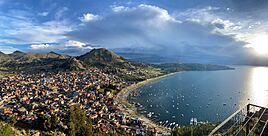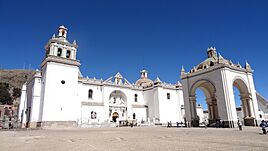Copacabana, Bolivia facts for kids
Quick facts for kids
Copacabana
Kotakawana
|
|
|---|---|
|
Panorama of Copacabana and Lake Titicaca, 6 de agosto Avenue, parade in Copacabana, Eduardo Abaroa Naval Monument, an Aymara man and a totora boat, Basilica of Our Lady of Copacabana
|
|
| Country | |
| Department | La Paz Department (Bolivia) |
| Province | Manco Kapac Province |
| Municipality | Copacabana Municipality |
| Area | |
| • Total | 346.5 km2 (133.8 sq mi) |
| • Land | 340.1 km2 (131.3 sq mi) |
| • Water | 6.4 km2 (2.5 sq mi) |
| Elevation | 3,841 m (12,602 ft) |
| Population
(2006)
|
|
| • Total | 6,000 |
| • Density | 358.5/km2 (929/sq mi) |
| Time zone | UTC−4 (BOT) |
| Area code(s) | Area code 591 |
| FIPS code | 45-16000 |
| Climate | Cwc |
| GNIS feature ID | 1245051 |
Copacabana is a lively town in Bolivia. It sits right on the edge of Lake Titicaca, which is a very famous lake. About 6,000 people live here, nestled between Mount Calvario and Mount Niño Calvario.
The town is well-known for its huge 16th-century church, the Basilica of Our Lady of Copacabana. This church is dedicated to Our Lady of Copacabana, who is the special patron saint of Bolivia. Many people visit Copacabana because it's a popular tourist spot. Visitors also enjoy the fresh trout and the town's charming, peaceful feel. From Copacabana, you can take a boat to Isla del Sol, a sacred island important to the ancient Inca people. The town even has its own airport, Copacabana Airport.
Contents
A Look Back: Copacabana's History
Copacabana has a long and interesting history. Before 1534, it was an important outpost for the Inca Empire. The Incas saw it as a key spot to reach a very old and sacred place on the Island of Titicaca. They respected the local Aymara people's traditions and worshipped there too.
When the Spanish arrived in the 1530s, they brought new beliefs. The Dominican priests made Copacabana a center for their missions. Later, other priests took over, and finally, the Augustinians were in charge by 1589.
The Story of the Statue
In 1582, a special event happened. A man who was a grandson of the Inca ruler Manco Kapac was inspired by statues of the Virgin Mary he saw in churches. He decided to create his own statue. After many tries, he made a beautiful one. This statue was placed in Copacabana and became known as the protector of the community.
Many people believe this statue has brought about miracles. Its fame has spread far beyond Bolivia. Today, it is kept in a special chapel. People from the local Aymara community, from all over Bolivia, and from around the world come to show their devotion.
Festivals and Traditions
Copacabana is famous for its lively local celebrations. Even during a big uprising in 1781, the special chapel holding the statue remained safe. On February 2nd and August 6th, the town celebrates Church festivals. These events include traditional indigenous dances that are a big part of the local culture. Around Copacabana, you can also find interesting ruins from the time before Columbus.
Copacabana's Climate
Copacabana has a cool climate all year round. It's known as a cold subtropical highland climate. This is because the town is very high up, at an elevation of about 3,841 meters (12,602 feet). Even though it's in the tropics, the high altitude keeps temperatures mild.
During the day, temperatures usually stay around 15°C (59°F). At night, especially in the "low-sun" season (which is like winter), it can get quite chilly. Sometimes, temperatures even drop below freezing. The town gets most of its rain during the "high-sun" season (like summer).
| Climate data for Copacabana, Bolivia, elevation: 3,815 metres (12,516 ft), 1981–2010 normals, extremes 1943–present | |||||||||||||
|---|---|---|---|---|---|---|---|---|---|---|---|---|---|
| Month | Jan | Feb | Mar | Apr | May | Jun | Jul | Aug | Sep | Oct | Nov | Dec | Year |
| Record high °C (°F) | 27.0 (80.6) |
23.0 (73.4) |
23.0 (73.4) |
28.0 (82.4) |
28.0 (82.4) |
28.0 (82.4) |
28.0 (82.4) |
27.0 (80.6) |
27.0 (80.6) |
23.5 (74.3) |
26.0 (78.8) |
25.6 (78.1) |
28.0 (82.4) |
| Mean daily maximum °C (°F) | 15.1 (59.2) |
15.2 (59.4) |
15.1 (59.2) |
14.9 (58.8) |
14.4 (57.9) |
13.4 (56.1) |
13.3 (55.9) |
14.0 (57.2) |
14.7 (58.5) |
15.5 (59.9) |
16.0 (60.8) |
16.0 (60.8) |
15.0 (59.0) |
| Daily mean °C (°F) | 10.2 (50.4) |
10.2 (50.4) |
10.2 (50.4) |
9.8 (49.6) |
8.9 (48.0) |
7.8 (46.0) |
7.7 (45.9) |
8.3 (46.9) |
8.9 (48.0) |
10.0 (50.0) |
10.5 (50.9) |
10.7 (51.3) |
9.5 (49.1) |
| Mean daily minimum °C (°F) | 5.3 (41.5) |
5.2 (41.4) |
5.3 (41.5) |
4.8 (40.6) |
3.4 (38.1) |
2.2 (36.0) |
2.1 (35.8) |
2.7 (36.9) |
3.2 (37.8) |
4.5 (40.1) |
5.1 (41.2) |
5.4 (41.7) |
4.0 (39.2) |
| Record low °C (°F) | −5.0 (23.0) |
−4.0 (24.8) |
−5.5 (22.1) |
−6.5 (20.3) |
−6.5 (20.3) |
−7.5 (18.5) |
−8.0 (17.6) |
−9.0 (15.8) |
−8.0 (17.6) |
−7.0 (19.4) |
−6.5 (20.3) |
−4.5 (23.9) |
−9.0 (15.8) |
| Average precipitation mm (inches) | 184.7 (7.27) |
113.0 (4.45) |
111.5 (4.39) |
52.4 (2.06) |
16.0 (0.63) |
11.5 (0.45) |
9.2 (0.36) |
16.7 (0.66) |
28.7 (1.13) |
45.5 (1.79) |
63.4 (2.50) |
108.8 (4.28) |
780.7 (30.74) |
| Average precipitation days | 19.4 | 13.6 | 13.3 | 7.8 | 2.4 | 2.3 | 1.7 | 2.8 | 5.2 | 6.5 | 8.1 | 13.0 | 97.1 |
| Average snowy days | 0.0 | 0.0 | 0.0 | 0.0 | 0.0 | 0.0 | 0.0 | 0.0 | 0.0 | 0.0 | 0.0 | 0.0 | 0.0 |
| Average relative humidity (%) | 66.5 | 66.0 | 66.1 | 62.7 | 57.6 | 56.7 | 55.0 | 56.2 | 56.0 | 56.6 | 57.3 | 60.7 | 59.4 |
| Source: Servicio Nacional de Meteorología e Hidrología de Bolivia | |||||||||||||
Places to Visit
If you're in Copacabana, here are some interesting places you might want to explore:
- Chinkana
- Iñaq Uyu
- Pachat'aqa
Gallery
See also
 In Spanish: Copacabana (Bolivia) para niños
In Spanish: Copacabana (Bolivia) para niños
















